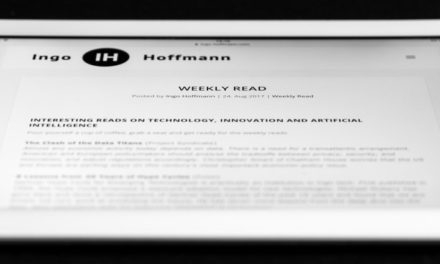
The decade of Artificial Intelligence
We are already in the middle of the decade of artificial intelligence (AI) and yet this unstoppable technological achievement is often viewed and discussed with skepticism. Is this development really so different from the innovations of the last 50 years that have become an integral part of our current lives and society? I will explains why it is so important, especially for Europe, to understand AI and especially machine learning (ML), and actively promote its use.
Benedikt Evans (source) has compared machine learning to the introduction of the relational database in the 1970s. A helpful comparison. Relational database models fundamentally changed the efficiency of data storage and thus the possibilities of software development in the seventies and eighties of the last century. This was initially recognized by few people.
The founders of SAP, however, took advantage of this development. Standard software such as ERP (Enterprise Resource Management) and CRM (Customer Relationship Management) are based on relational databases, as are online stores and much more. Companies such as SAP or Amazon would not exist without relational databases. Today, relational databases are used by almost all companies – and are often no longer noticed.
We are living in the information revolution, which is just 50 years old and based on innovations like PCs, databases, the Internet and smartphones. The pace of development is getting faster and faster as each innovation builds on the previous one. The coming decade marks the beginning of the intelligence revolution, the age of Artificial Intelligence (AI).
AI and Machine Learning are creating new ways to use data and software. This time, the potential is much greater than with databases. AI brings us not only more efficiency – but additional intelligence.
AI is not new. The Dartmouth Conference of 1956 is considered the birth of artificial intelligence. But machine learning has only made its breakthrough in the past decade. In particular, Deep Learning (source) enables recognition of images and speech (think Alex, Siri) and in 2016 AlphaGo (source) beat the world champion in Go – 10 years earlier than any expert expected.
AI now has the potential to change everything and optimize all other technologies . With AI, new materials can and will be developed. It will change the way we learn. Our interaction with the environment and our working world will be changed by AI. Likewise, it will affect how we make decisions and steer our society(s). In healthcare and the fight against disease, AI will enable us to find new ways. In short, it will affect every single aspect of human existence and society.
Another existential area for the use of AI is industry.
We are in the first 10 years of this new era that will redefine many industries and product categories. The foundations for the new (or new old) market leaders are being laid in these years. For example, Bosch in Germany aims to either develop its products with AI by 2025 or they will include AI . (source)
Analyses and figures also demonstrate the potential. PwC has shown in a study (source) that AI can add US$ 15.7 trillion to global economic growth in 2030. By comparison, China has a GDP of US$ 14.3 trillion in 2019. The market for AI-based solutions will grow from just under US$ 60 billion in 2019 to US$ 158 billion in 2023 (Source IDC, Gartner, PitchBook). Many countries have created an AI strategy and planned investments to ensure their competitiveness and promote the development of AI (source). Germany has increased its AI investment from €3 billion to €5 billion by 2025 (source) and is launching a Future Fund, €10 billion over the next 10 years, focusing on high-growth startups and new technologies such as AI and BioTech (source). The EU plans to invest €2.5 billion in AI by 2027 (source). China aims to become the world’s leading AI nation by 2030 – in research, innovation and applications. Billions of $ are being invested nationally and regionally to achieve this. National figures are not published, but 2 regions alone (Shanghai, Tianjin) have planned $ 15 billion each in AI investments (source). Saudi Arabia plans to invest US$30 billion in AI by 2030 (source).
Even the U.S., which has so far relied on the strength of its universities in AI research and private investment by Google, Amazon, Facebook, Apple and co.), is strengthening public AI investment. On Jan. 1, 2021, Congress also approved about $6.5 billion for AI demand in the non-military sector as part of the National Defense Authorization Act (source).
A lot is happening, but often these developments are hard to see in our daily lives.
We use AI every day with our smartphones (facial recognition, Siri and Alexa), Google search or online shopping (recommendations). It’s so normal that we don’t see it as AI anymore. On the other hand, AI is dominated by science fiction imagery (Terminator) or is decried as a job killer (the robots are taking over all the jobs). In many companies, AI has not yet arrived. Since AI is not always a “visible” technology, such as smartphones, the possibilities in the working world are only slowly becoming apparent.
Many AI projects in companies today are still tests, so-called proofs of concepts. The topic of AI is often seen as hype, which is partly true. Gartner shows in the AI Hype Cycle (source) that many of the AI technologies are currently at the peak of hype, or are on their way into the valley of disillusionment.

Source: Gartner
However, it also becomes clear that in the next 2-5 years, many of these technologies, such as machine learning, deep neural networks, chatbots, or computer vision, will reach the plateau of productivity.
The next few years will see the emergence of more and more AI-based solutions and companies that are superior to current approaches.
We can already see this happening in the B2C solutions space. Companies like Google, Amazon, Apple, Facebook or in China, Tencent and Alibaba, are leading the way in the use (and advancement) of AI. Their market success is largely based on their strategic use of AI across the board.
As a result, they have become the most valuable companies (by stock market value) in the world and the best examples of the winners of the Internet AI wave.
Kai-Fu Lee, a well-known AI researcher and current investor, outlined four waves of AI adaptation in his book “AI Superpowers,” published in 2018:
- First Wave: Internet AI
- Second wave: business AI
- Third wave: perception AI
- Fourth wave: autonomous AI
The first wave was based on the use of consumer data, for example for recommendations in online stores, search engines or personalized marketing. This wave is behind us. The cards are dealt here; the lead of companies in the USA and China cannot be made up.
The second wave is on the move and is based on the use of business data. There are no clear winners here yet, and Europe has a good chance of developing successful companies here.
The third wave is based on the previous two and adds the real world – using sensors and AI’s ability to “see”, “hear” and “understand” speech. From personal AI assistants to smart factories. We are at the beginning of this wave, which can play a crucial role for Europe and our industry. Industry 4.0 was invented as a concept in Germany (source), now we can use the potential of our economy and our research to develop leading companies and solutions for the future.
The fourth wave brings autonomous systems and machines. This is where the greatest potential and changes for industry and our everyday life lie.
Author’s aside: “Kai-Fu Lee is very skeptical about AI development in Europe. He primarily sees China and USA as the winners. I don’t agree with him on that! But we need to exploit the potential in Europe now.”.
All of this will develop over the next 10 years. The waves will come faster than many currently believe. We are looking at exponential growth.
Data is the foundation for the productive use of AI. Over the next few years, the amount of data available will grow exponentially. IDC (source) predicts that by 2025, 175 zettabytes of data will be produced (2018 comparison: 33 zettabytes). Of this, 90 zettabytes will come from smart sensors. 75% of the world’s population will interact with data daily, triggering an interaction every 18 seconds. Coupled with the increasingly prolific AI technologies (see Gartner Hype Cycle) that will be available in the next few years, this will lead to an exponential increase in AI-based applications.
We have not yet taken into account that AI research is also evolving rapidly, driven by large investments in developed countries. Many AI technologies that will be used in 10 years are not yet “invented” today. But the AI capabilities known today alone will enable the developments described here in this decade.
This creates a fantastic potential for investors to invest in the future market leaders. It shows the need for companies of all industries and sizes to understand the topic and potential use of AI. And to actively use it better today than tomorrow. New business models will emerge. Entrepreneurship will become more important than ever. New jobs will emerge, and collaboration between humans and AI will become the norm. As a society, we need to better understand what opportunities and changes AI brings and how we deal with them. New risks are emerging, for companies, users and societies. These need to be recognized and addressed. New regulations will be needed, but they should not limit the innovation potential of AI from the outset.
In short, there is much to be done.
Just as with the relational database, in 10 years no one will say a solution or a machine uses AI. This will be normal. But there is still a long way to go before that happens.
Similar to how it was not clear in the 1970s that SAP would one day become a global market leader, it is not yet clear today which new AI business ideas and which AI startups will become the next global market leaders.
We overestimate the near-term possibilities of new technologies like AI. Expectations are disappointed and the technology is dismissed as hype. But in doing so, we underestimate the long-term possibilities (think of the Internet hype of the 2000s). With a technology like AI that is developing exponentially, this is a critical mistake we must avoid.
Like all foundational technologies, AI and machine learning will evolve. From a novelty to mainstream, it will become invisible as an indispensable component in 10 years. Like electricity or databases before.
Only it will be happening faster than ever before.




